
Airspace Structure
Chapter 20.1
Flight Information Region (FIR)

The flight information region of Switzerland is divided into the two control areas (CTA) of Zurich and Geneva. The separation line between the two control areas passes on the west side of Berne. In each of these areas, a specific unit is responsible for the flight information service. Its task is to provide information to flight crews at their request (weather, restrictions, other air traffic, etc.). In addition, flight plans can also be changed or re-filed on this frequency. In the event of an emergency, the flight information service can also ensure alerting (alerting service).
In Switzerland, "zurich- oder geneva information" is basically responsible for aircraft in Class E and G airspace and does not actually manage traffic. It therefore does not issue any clearances or prohibitions and does not actively separate aircraft from each other.
Civil Control Zones (CTR)

To protect aircraft from uncontrolled approaches and the risk of collisions during arrivals and departures, as well as on aerodrome circuits, special control zones (CTR) have been established around larger airports. In Switzerland, the control zones are classified as Class D. The lower limit of these airspaces is always the ground (GND). The upper limit varies depending on the local conditions of the airport.
In these CTRs, the air traffic controllers of the corresponding airport are responsible (approach or tower) to control and guide air traffic.
Airways (AWY) and Terminal Control Areas (TMA)

Airways are frequently flown, predetermined routes (lateral and vertical) between navigation aids. The most important airways in Switzerland lead from Zurich to Milan (A9), and from Zurich to Geneva (G5).
The TMAs are actually the links between the large airports and the airways in which the climbing and descending flights of the aircraft are guided. The structure of these TMAs is quite complex, especially in Switzerland. In general, it can be said that the lower limit of a TMA is never the ground (GND). This means that TMAs can be flown below. Furthermore, the closer a TMA gets to the CTR, the lower its lower limit becomes.
Military CTR and TMA
Military control zones (CTR) and terminal control areas (TMA) are not continuously active. Activation times depend on military flight times and air force needs.
It should be noted that the CTR/TMA Payerne in particular can be active at any time. This is due to the operational fighter jets, which can take off around the clock for air police missions.
Military Training Areas
The military training airspaces TRA/TSA (Temporary Reserved and Segregated Areas) are located over the Alps, divided by Airway A9, and over the Jura. The lower limits of the airspaces over the Alps are FL 130, over the Jura FL 100. The activation of the zones Saentis and Schratten with lower limit FL 100 is published in the Daily Airspace Bulletin Switzerland (DABS).

Military Operating Hours
Military operating hours influence the classification of airspaces over the Alps as well as military CTRs and TMAs.

Standard military flight schedules. These may be extended at any time, particularly with regard to CTRs and TMAs.